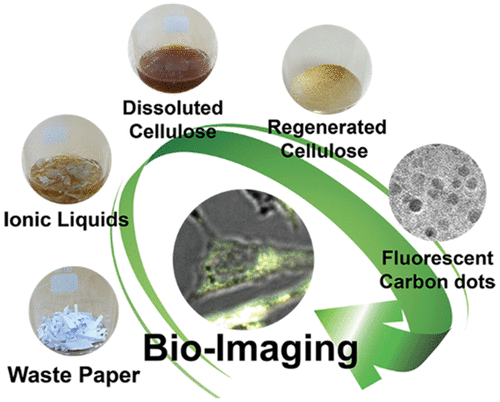Title: Converting Waste Papers to Fluorescent Carbon Dots in the Recycling Process without Loss of Ionic Liquids and Bioimaging Applications
Authors: Yoon Jeong, Kyunghwan Moon, Soohyun Jeong, Won-Gun Koh, and Kangwon Lee
Year: 2018
Journal: ACS Sustainable Chemistry & Engineering
https://pubs.acs.org/doi/pdf/10.1021/acssuschemeng.8b00353
Featured image and all figures used with permission via ACS AuthorChoice open access.
What do you think we can make from waste paper? Newspaper? Carton boxes? More papers? Scientists have now found out a way to use waste papers to make bioimaging sensors that can be used for detecting activities of cells in the body! Looks fancy? Let’s learn more about it!
Papers are materials made from trees. Since living things contain many carbon atoms, papers are a good source of carbon. One of the differences between plant and animal cells is that plant cells have a cell wall. This cell wall gives shape to the cell, maintaining its rigid structure. The main material composing the cell wall is cellulose, which contains 90-99% carbon. In view of this, scientists used cellulose to make a new material called a carbon dot, which could be our future bioimaging sensors!
What are carbon dots?
Carbon dots are not the dots drawn from your pencil. They are nanoparticles, so small that their physical and chemical properties are different from their larger counterparts. These carbon dots are nanoparticles made from carbon. Since plant materials contain much carbon, they are the raw materials for making carbon dots. These intriguing dots are often fluorescent – they shine after absorbing light. This optical property has led to great applications like biosensing, drug delivery, and bioimaging for medical use.
However, one of the current challenges in making carbon dots lies in breaking down cellulose from plants. Cellulose contains many intramolecular and intermolecular hydrogen bonds which make it difficult to break. Another roadblock is the high cost of solvents. Therefore, it is of practical concern not to consume ionic liquids during the carbon dot synthesis process. Researchers have now filled these gaps by proposing a new method with waste papers!
How to turn waste papers into carbon dots
The solvent for dissolving cellulose in plant cells is called ionic liquids (ILs). They are organic salts in liquid form. ILs can weaken and break the hydrogen bonds in the cellulose, making it easier to regenerate cellulose from waste papers. Scientists then heat up the mixture with microwave heating. (Note: This is totally different from putting waste papers into a microwave!) This changes the structure of cellulose and fuses them into one another. They then add ethanol to extract both regenerated cellulose and ionic liquids. As ILs have stronger interaction with ethanol than cellulose (i.e. ILs like ethanol more than cellulose), they go with ethanol and leave behind the regenerated cellulose. This allows scientists to reuse the ILs and convert the remaining cellulose into carbon dots (Figure 1).

Figure 1. Schematic illustration of how waste papers generate carbon dots. (i) The recycling of waste papers: Ionic liquids dissolve cellulose in waste papers, which is recovered by adding ethanol for reuse. The structure of cellulose changes from fiber to chain during the process. (ii) The cellulose extracted generates carbon dots with value-added product. (iii) The carbon dots are suitable for bioimaging applications. It glows under UV light.
How can these carbon dots become bioimaging sensors?
Under UV light, these carbon dots emit visible blue light. To fit for use in medical operations, these carbon dots have to be safe inside the body. Therefore, scientists have tested them with living cells. They have showed that some living cells take in the carbon dots into the regions near the nucleus without toxic effects. This suggests the carbon dots could be used for biolabeling or bioimaging in medical applications.
While this research suggests a new outlet for waste papers, it is still important to keep in mind not to waste our natural resources! It is not just about waste papers; scientists have to make an effort to recycle our general waste to something useful. So let us be responsible global citizens and take good care of our precious planet!

